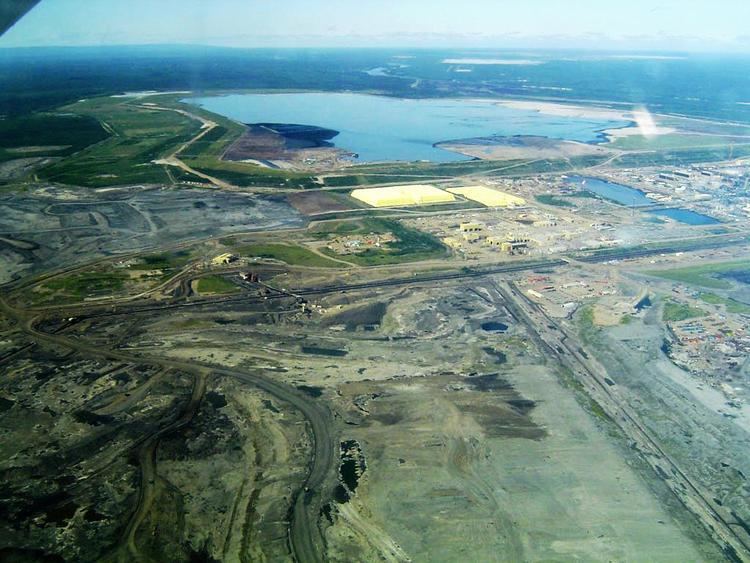 | ||
Similar Waste weir, Wing dam, Splash dam | ||
A tailings dam is typically an earth-fill embankment dam used to store byproducts of mining operations after separating the ore from the gangue. Conventional water retention dams can serve this purpose, but due to cost, a Tailings dam is more viable. Tailings can be liquid, solid, or a slurry of fine particles. Solid tailings are often used as part of the structure itself.
Contents
Tailings dams rank among the largest engineered structures on earth. The Syncrude Mildred Lake Tailings Dyke in Alberta, Canada, is an embankment dam about 18 kilometres (11 mi) long and from 40 to 88 metres (131 to 289 ft) high. It is the largest dam structure on earth by volume, and as of 2001 it was believed to be the largest earth structure in the world by volume of fill.
There are key differences between tailings dams and the more familiar hydro dams. Tailings dams are designed for permanent containment, meant to "remain there forever". Copper, gold, uranium and other mining operations produce varied kinds of waste, much of it toxic, which pose varied challenges for long-term containment.
An estimated 3,500 active tailings impoundments stand around the world, although there is no complete inventory, and the total number is disputed. As of 2000 these structures experience known "major" failures of about 2 to 5 annually, along with 35 "minor" failures. Assuming the 3,500 figure is correct, this failure rate is "more than two orders of magnitude higher than the failure rate of conventional water retention dams".
Structure
Unlike water retention dams, a tailings dam is raised in succession throughout the life of the particular mine. Typically, a base or starter dam is constructed, and as it fills with a mixture of tailings and water, it is raised. Material used to raise the dam can include the tailings (depending on their size) along with dirt.
There are three raised tailings dam designs, the upstream, downstream and centerline, named according to the movement of the crest during raising. The specific design used is dependent upon topography, geology, climate, the type of tailings, and cost. An upstream tailings dam consists of trapezoidal embankments being constructed on top but toe to crest of another, moving the crest further upstream. This creates a relatively flat downstream side and a jagged upstream side which is supported by tailings slurry in the impoundment. The downstream design refers to the successive raising of the embankment that positions the fill and crest further downstream. A centerlined dam has sequential embankment dams constructed directly on top of another while fill is placed on the downstream side for support and slurry supports the upstream side.
List of largest tailings dams
Type: TE - Earth; ER - Rock-fill; PG - Concrete gravity; CFRD - Concrete face rock fill
Concerns
The standard of public reporting on tailings dam incidents is poor. A large number remain completely unreported, or lack basic facts when reported. There is no comprehensive database for historic failures.
Failure rate
The lack of any comprehensive tailings dam database has prevented meaningful analysis, either gross comparisons (such as country to country comparisons, or tailings dam failures versus hydro dam failure rates) or technical failure analysis to help prevent future incidents. The records are very incomplete on crucial data elements: design height of dam, design foot print, construction type (upstream, downstream, center line), age, design life, construction status, ownership status, capacity, release volume, runout, etc.
An interdisciplinary research report from 2015 recompiled the official global record on tailings dam failures and major incidents and offered a framework for examining the severity and consequence of major incidents. That report shows a correlation between failure rates and the pace of copper ore production, and also establishes a relationship between the pursuit of lower grades of ore, which produces larger volumes of waste, and increasingly severe incidents.
Environmental damage
The mining and processing byproducts collected in tailings dams are not part of the aerobic ecological systems, and are unstable. They may damage the environment by releasing toxic metals (arsenic and mercury among others), by acid drainage (usually by microbial action on sulfide ores), or by damaging aquatic wildlife that rely on clear water.
Tailings dam failures involving significant ecological damage include:
Tailings ponds can also be a source of acid drainage, leading to the need for permanent monitoring and treatment of water passing through the tailings dam. For instance in 1994 the operators of the Olympic Dam mine, Western Mining Corporation, admitted that their uranium tailings containment had released of up to 5 million m3 of contaminated water into the subsoil. The cost of mine cleanup has typically been 10 times that of mining industry estimates when acid drainage was involved.
Casualties
The following table of the deadliest known tailings dam failures is not comprehensive, and the casualty figures are estimates.
